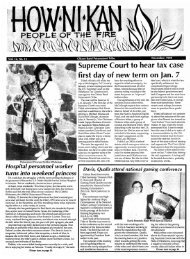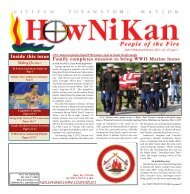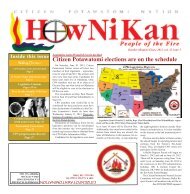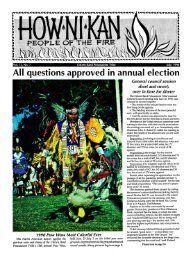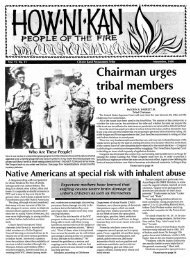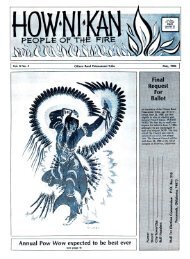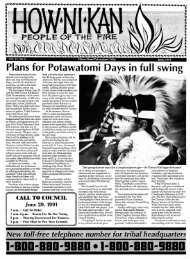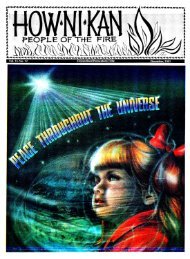Tax Commission declares war - Citizen Potawatomi Nation
Tax Commission declares war - Citizen Potawatomi Nation
Tax Commission declares war - Citizen Potawatomi Nation
You also want an ePaper? Increase the reach of your titles
YUMPU automatically turns print PDFs into web optimized ePapers that Google loves.
..age 0<br />
The Bourbonnais of Kankakee<br />
Editor's Note: The HowNiKan is grateful to author Vic Johnson<br />
and the Kankakee, Illinois Sunday Journal for reprint rights on the<br />
following article.<br />
In 1833, one family - the Bourbonnais - owned most of the land on<br />
which the city of Kankakee now stands.<br />
Catfish, the <strong>Potawatomi</strong> wife of Francois Bourbonnais Sr., her son<br />
Washington, and Maw-te-no, daughter of Francois Bourbonnais Jr.,<br />
were given one section of land each by the Treaty of Camp Tippecanoe.<br />
The Treaty Council, held October 20, 1832, negotiated title transfer<br />
of <strong>Potawatomi</strong> land that lay north and east of the Kankakee River to<br />
the United States. It also reserved certain tracts of land for the lifetime<br />
use of individual Indians and mixed-bloods of Indian descent known<br />
as Metis.<br />
A year after the treaty was signed, Catfish sold the eastern half of<br />
her section to Samuel Russell for $600. In 1847 and 1848, long after the<br />
Bourbonnais had departed from the oak and hickory crowned ridge<br />
southeast of Soldier's Creek, the remaining land was bought by Isaac<br />
Elston and August M. Wiley. These sales were recorded in two counties<br />
in western Missouri, indicating that the Bourbonnais were living<br />
either there or in eastern Kansas at that time.<br />
The withdrawal of the Bourbonnais, other Metis families and the<br />
Indians from Illinois in the middle 1830's ended an era of 130 years or<br />
more of intermarriage" between the French-Canadian fur traders and<br />
women of the western Algonquin tribes. These marriages had produced<br />
large families of mixed-blood offspring who played decisive<br />
rolls in the destinies of midwestern Indian tribes.<br />
Many Metis became headmen or chiefs and negotiated treaties between<br />
the Indians and white government officials; some grew to be<br />
defiant <strong>war</strong>riors who fought the west<strong>war</strong>d migration of settlers. Along<br />
with their Indian brethren, the Metis mourned the loss of the French<br />
"fathers" after Canada fell to the British.<br />
Although the Metis called the English, and later the Americans,<br />
"my brothers," their hearts were with the "Waybaymishetome," the<br />
French, and they looked to<strong>war</strong>d the day when France would reclaim<br />
its lost empire in North America.<br />
Time, politics, and a tide of Anglo-SaxoIL settlers from the east<br />
coast eventually stripped the Metis of their fragile hybrid cldtu~e.<br />
Neither white nor Indian, they became the middlemen of fronlIer m<br />
trigue - the brokers of Indian power - while at the same time fighting a<br />
desperate battle to prevent the collapse of their own outland society..<br />
Finally, the Indian Removal Act of 1830 forced the hard chOIce<br />
upon them: Live as the white men do, or deliver up your lands and<br />
take your lodges west of the Mississippi. Most eventually chose the<br />
long trail west. . "<br />
By 1837 the Metis families, the Bourassa, LaframbOls, Beaublens,<br />
Jonvcaus, Bourbonnais, Levias, Oiulmettcs, Bertrands, Burnetts..., h~d<br />
abandoned the prairie groves, their beloved sugar trees and the fruItful<br />
river valleys of Illinois to face an uncertam future on the and,<br />
short-grass western plains. . .<br />
Local history says very httle about the MelIs, even though the Chevaliers,<br />
jonveaus, Livias, Coutremans and BourbonnaIS once owned<br />
land along the Kankakee. .<br />
We are not certain, for example, for whom the Village of Bourbonnais<br />
is named.<br />
Was its namesake Francois Bourbonnais Sr., or some other Bourbonnais<br />
- his son Francois, Jr., perhaps?"<br />
Another son, Washington, has been said by some to have been the<br />
man for whom Bourbonnais Grove was named.<br />
Gurdon S. Hubbard, who was superintendent of the Illinois Brigade<br />
of the American Fur Company, recollects in his published memoirs<br />
that the Bourbonnais he knew on the Kankakee answered to<br />
the name of Antoine.<br />
All four Bourbonn,!is are genuine historic persons. Their na~es<br />
and brief mentions of their activities appear on the pages of several<br />
documents of the times.<br />
Washington Bourbonn~is is th~ most ob5C~re. That he died before<br />
his land was sold in 1848 IS certam because hIS mother, brothers and<br />
sisters are named as heirs in the abstract of title.<br />
The Antoine Bourbonnais remembered by Hubbard to be "a large<br />
and portly man, and for his years...very energetic," could have been<br />
the Antoine "Bulbona" who kept a trading post on Bureau Creek,<br />
some miles north of Peoria in the late 1820's. Bureau County hlstonan<br />
N. Matson describes him as "a large raw-boned, dark complexioned<br />
man... (who) had a course b~ss voice." During the Black Hawk War<br />
(1832) Bulbona and his family fled Bureau Creek, never to return.<br />
Francois Bourbonnais Sr"1 possibly a brother to Antome of Bureau<br />
Creek, is believed to have brought hiS famIly to the Kankakee<br />
Bourbonnais Grove area in eiiher 1829 or 1830. Before 1828 he was hving<br />
at the old French trading house, three m!leS below Peoria on the<br />
east bank of the Illinois River, where he was hcensed to keep a tavern.<br />
Francois Bourbonnais Jr., perhaps a half-brother to Washington<br />
and the other Bourbonnais children, stands as somewhat of a mystery.<br />
He appears to be the oldest of Francois Senior's children, and may be<br />
the child of a previous marriage. He too was licensed to keep a tavern<br />
at the trading house, and in 1825 he was assessed $100 in personal<br />
property tax. The Treaty of Prairie du Chien, 1829, gave one "Francois<br />
Broubonne Jr." one section of land on Mission Creek, just east of the<br />
Fox River in Lasalle County. lt is not known if Francois Jr. ever lived<br />
there, but a cabin was built for him on his daughter's land at Soldier's<br />
Village by Case Wadley in 1834.<br />
The whole Bourbonnais clan was living on the Kankakee in 1834.<br />
Francois Jr.'s cabin was just north of the line which separated Maw-teno's<br />
reservation from Catfish's. This cast-west boundary almost evenly<br />
divided Soldier's Village. According to the field survey notes the<br />
lodges were scaltered over an area of about one-quarter of a square<br />
mile, its center being where the Kankakee County court house is located<br />
now. The senior Bourbonnais and Catfish are believed to have<br />
been living in a cabin on the river south of the village. It is reported<br />
that during this year 100 acres of Catfish's land was plowed for cultivation<br />
by Wadley. Despite the appearance of having settled-in, the Bourbonnais<br />
abandoned their holdings in 1836.<br />
In 1830, at the time the Bourbonnais were living at "La Pointe,"<br />
the apex of a grove of timber on the upper reaches of Bourbonnais<br />
Creek, the population of tlie United States stood at 12,866,020, and Illinois<br />
had been a state for 12 years.<br />
The next decade would see five million more Americans added to<br />
the census, the opening of the Oregon Trail, McCormick's reaper in<br />
the grain fields of the east, railroad lines linking together eastern cities,<br />
weekly steamboat service between Chieago and Buffalo, the invention<br />
of the telegraph, Samuel Colt's six shooter, American faces on<br />
Daguerreotype plates, and all Indian lands east of the Mississippi ceded<br />
by treaty to white ownership.<br />
Nobody knew exaetly how big America was in 1830 - except that it<br />
wasn't big enough for the settlers and the Indians once the prairies<br />
were squared-off into 640 acre sections by the surveyors. Where cessions<br />
had been made, one <strong>Potawatomi</strong> chief remarked: "The plowshare<br />
is driven through our tents before we have time to carry out our<br />
goods and seek other habitation."<br />
From 1833 to 1837 wildcat land speCUlation brought boom times to<br />
the frontier. New roads and canals, and the lure of cheap land drew<br />
thousands of immigrants into Illinois.<br />
On some as yet unknown day - most likely in the year 1836 - the<br />
Bourbonnais gathered together their possessions and joined one of<br />
the departing <strong>Potawatomi</strong> bands. Their destination was a 3100 square<br />
mile tract of land that lay between the western boundary of the MISsouri<br />
River and Missouri.<br />
The Plalte Country, as it was called, had been a<strong>war</strong>ded to the <strong>Potawatomi</strong><br />
by the 1833 Chicago Treaty.<br />
Plalte Country was·soon annexed by the State of Missouri, and the<br />
Indians and Metis families who had settled there were marched off to<br />
a new 1ndian sub-agency at Council Bluffs, Iowa.<br />
The baptismal register of the Kickapoo and Council Bluffs Mission<br />
records the baptism of an "Antony Bourbonnais, son of Frank Bourbonnais<br />
and Catherine Chevaher," on July 13, 1838. "At the same time<br />
were baptized Mary Oside B., 16 years old and Catherine, 11 years old."<br />
Antony (Antoine) was then about 13 years old. It appears likely he had<br />
been born near Peoria when the Bourbonnais were living at the old<br />
French trading house. . .<br />
The names have been anglicized in the register, but there .s httle<br />
doubt that these Bourbonnais are the same people who lived at Bourbonnais<br />
Grove and the Kankakee. The heirs of Washington Bourbonnais<br />
are named as Antoine, Peter, Oyette, Catherine and Catfish. On<br />
the abstract of title to Washington's reserve, Catfish is. spelled Catecha<br />
and the name spelled Oyette is a misspelling of Ozette. Ozelle is the<br />
Indian version of Josette. The name Mary Oside B. on the baptismal<br />
register is most likely Mary Ozelle (Josette) Bourbonnais. Catfish is the<br />
Indian equivalent of Catherine. A Canadian genealogical record notes<br />
that Francois Bourbonnais married a Catherine Chevalier.<br />
There has always been a question whether this Catherine Chevalier<br />
was the Indian woman Catfish. Again, there is no certain answer.<br />
However the Chevalier name is associated with mixed-blood families<br />
from the St. Joseph River region of southwestern Michigan. In 1826<br />
Alexander Robinson, a mixed-blood Potawatoml chIef m Chlcag~,<br />
married a Catherine Chevalier who was the daughter of one FrancoIS<br />
Chevalier, "an important <strong>Potawatomi</strong> of St. Joseph, Michigan." Bourbonnais'<br />
wife, Catherine, may have been an aunt or cousin to the girl<br />
who married Robinson.<br />
But what about the name Catfish?<br />
There are two entries in the Saint Joseph Baptismal Register<br />
where a Catherine L'arch or Larch (L'archeveque) signed her name as<br />
Catis. The <strong>Potawatomi</strong> language had no spoken sound for "r." Catherine<br />
Chevalier was probably known as Catfish Shobonier or Shabbona<br />
in <strong>Potawatomi</strong> villa~es.



